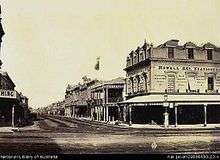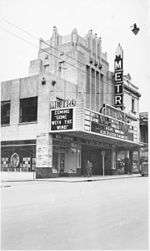Hindley Street, Adelaide

Hindley Street is located in the north-west quarter of the centre of Adelaide, the capital of South Australia. It runs between King William Street and West Terrace.[1] The street was named after British parliamentarian and social reformist, Charles Hindley.
Now known for its atmosphere and active nightlife,[2] the street was one of the first built in Adelaide and is thus of historical significance. The first newspaper in South Australia was printed in premises on Hindley Street.[3]
As well as housing the first meeting of Adelaide City Council, the oldest municipal body in Australia, Hindley Street was home to the first stone church in South Australia.[4] In 1898 the first moving picture to be shown in South Australia was held at the Theatre Royal on Hindley Street.
History
_-_Copy.jpg)

Hindley Street serves as one of Adelaide's most prominent early streets, with an extensive and illustrious history. The street itself was named in honour of British politician Charles Hindley.[6] The doings of the population of Adelaide were directly connected to the street, and when the city was first developed in the 1830s, permission was given to cut down trees in favour of constructing buildings and paving streets–the west end of Hindley Street being one of the first locations to receive such development.[7]
For many years, the street was the centre of trade and finance for Adelaide. Furthermore, it was expected to permanently hold that position as time passed. The reason for this was largely because Adelaide was a particularly young city at the time, with the majority of settlers coming from the west with the water sourced from the River Torrens.[7] Immigrants who landed at Port Adelaide would travel to a ford near Hindmarsh, then to the place where Morphett Street ends and Hindley Street begins.[7] Immigration Square was situated westward of the parklands, with most of Adelaide's business and trade being conducted westwards. The "trade" itself was dubious and the subject of much controversy at the time, with many residents outraged at the young girls who would travel down the street drunk due to alcohol trade.[7]
On 21 April 1856, the Port Adelaide Railway was officially opened and thus took most of the traffic away from Hindley Street.[7] This shaped Adelaide's changing geography, leading to the formation of what it is today–the suburbs away to the foothills in the east were developed, which meant the trade went east. A reporter on the street in in 1913: "The place was a veritable cradle for big concerns. First Ware's Exchange Hotel - a little down from King William Street. It is a history in itself, with its sketches and lingering memories of the pioneering days. To walk through its big low-ceilinged rooms is to think at once of the drovers and farmers who once made merry there. To see the photographs - quaint and laughable - of old George Coppin, the first lessee... when it was built in 1839 is to recall a good comedian of the early years."[7]

On 20 September 1855, an episode of violence erupted on Hindley Street. It was during the Legislative Council election, which saw a mob that attempted to interfere with the voting at West Adelaide.[8] Later that same day a much larger riot developed in the same place after the election was closed. At that time the British colony of South Australia was ruled by a governor appointed by the British government. In 1903, Adelaide's coffee palace, West Coffee Palace, was built on Hindley Street. The building remains at 110 Hindley Street to this day.

As the 1910s approached, Hindley Street entered a state of despair. The Advertiser, Adelaide's daily newspaper, began reporting on public intoxication in the street as early as 1911.[9] It would later become known for its state of debauchery well into the 21st century. Theatres, butchers and other business still thrived, despite the shifting of business away from Hindley Street. The Metro Theatre, one of Adelaide's earliest theatres, existed on the corner of Hindley and Victoria Street for many years until it was closed in 1972, then subsequently gutted in 1975 as a modern four-screen Greater Union cinema complex. It was here that the film Picnic at Hanging Rock (1975) had its world premiere. This cinema would not endure either, it was closed in 1991 and demolished in 2005. Currently on this site is 300 apartments for university student accommodation. Hindley Street was also home to one of Adelaide's most beloved theatres, The Theatre Royal.[10] Designed by Melbourne architect George R. Johnson, it was demolished in 1962 for a department store while a car park was built on the level above.
In the 1970s, 80s and 90s Hindley Street became known for its diversity: restaurants, pubs, roller rinks, theatres, cinemas and retail outlets were available along the strip, which had become Adelaide's unofficial main street. In the 1990s, it gained reputation for being Adelaide's red light district. However, in the early 2000s, the street experienced somewhat of a decline due to debauchery, alcohol fuelled violence and lack of daytime foot traffic. Alcohol fuelled violence and drunken behaviour along the street drove the Adelaide City Council to introduce a 3am lockout, in which all business (predominantly nightclubs) must refuse entry after 3am.[9]
Controversy
In 2009, one of Hindley Street's two McDonald's restaurants (the one on the corner of Bank Street) received global attention after it featured in a story on the US Drudge Report as 'The world's dirtiest McDonald's', a story that was later picked up by media outlets worldwide.[11] It was filmed and uploaded by Jeremy Brown.[11]
In popular culture
"Hindley Street", a song by famous Australian band Powderfinger on its album Internationalist, was written about the street. Hindley Street also features in the song "Carrington Cabaret" by Redgum on their 1978 album If You Don't Fight You Lose.
Architecture
 Theatre Royal c. 1881
Theatre Royal c. 1881 Returning soldiers march past Theatre Royal, Hindley Street
Returning soldiers march past Theatre Royal, Hindley Street- West's Coffee Palace, 110 Hindley Street, built in 1903.
- The Mayfair Hotel, 158 Hindley Street (formerly Colonial Mutual Life)
- High rise and The Little Pub on Hindley Street
 Roy Rene statue, Hindley Street
Roy Rene statue, Hindley Street
See also
![]() Australian Roads portal
Australian Roads portal
References
- ↑ 2003 Adelaide Street Directory, 41st Edition. UBD (A Division of Universal Press Pty Ltd). 2003. ISBN 0-7319-1441-4.
- ↑ Hindley street information, www.pleasetakemeto.com
- ↑ History of Adelaide through street names, www.historysouthaustralia.net
- ↑ John Blacket (1907). The Early History of South Australia: A Romantic Experiment in Colonization, 1836-1857. Methodist Book Depot.
- ↑ "Adelaide - Hindley St., From the Corner of King William St.". Wesleyan juvenile offering. London: Wesleyan Mission-House. VI. 1849. Retrieved 9 November 2015.
- ↑ Templeton, Anthony (11 April 2015). "Hindley Street: Is the party over after 178 years?". Adelaide Now.
- 1 2 3 4 5 6 "Adelaide Streets". State Library of South Australia. Retrieved 5 October 2015.
- ↑ "Hindley Street riot". SA History Hub. Retrieved 5 October 2005.
- 1 2 "Hindley Street: it wasn't always this way". indaily.com.au. 9 October 2013. Retrieved 5 October 2015.
- ↑ "Theatre Royal". Adelaide Heritage. Retrieved 5 October 2015.
- 1 2 McFilthy - you want gastro with that?, AdelaideNow, www.adelaidenow.com.au
External links
Coordinates: 34°55′24″S 138°35′39″E / 34.9233°S 138.5941°E
| Wikimedia Commons has media related to Hindley Street, Adelaide. |